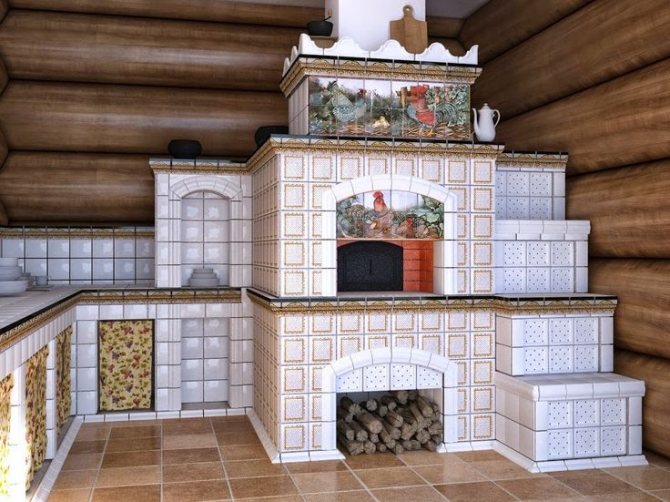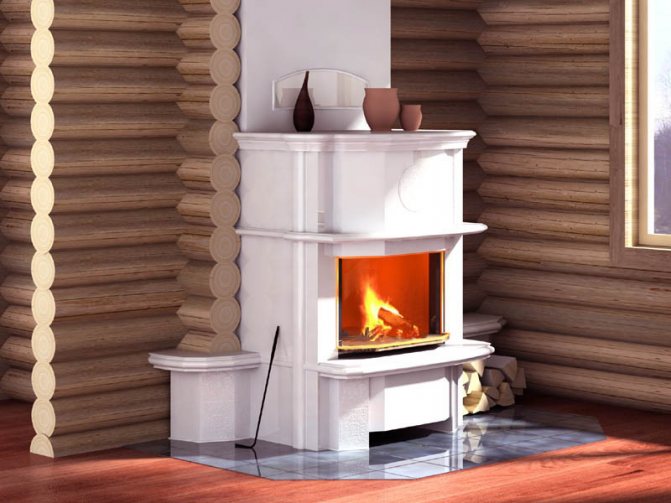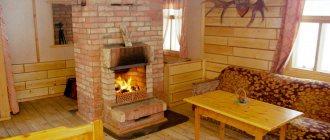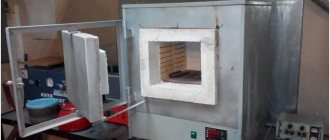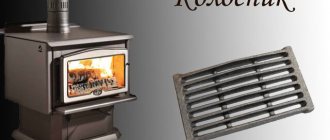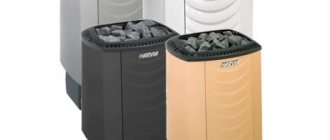A Russian brick stove, folded according to all the rules, gives half of the heat given off to the room into the room. However, this amount directly depends on the material covering its surface. Moreover, a rough surface gives off heat more than a smooth one. Since ancient times, stoves have been painted with lime in villages. The owners of the rich houses decorated the stoves with tiles, turning them into real works of art.
Currently, the best design for a brick oven is also its painting. But what is the best way to paint a brick stove?
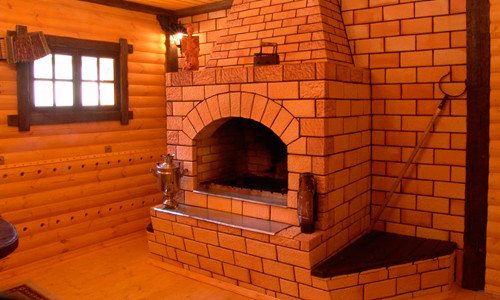
The amount of heat that a brick stove gives off to a house also depends on the material with which the stove is painted.
Painting with chalk or lime
A brick oven or brick fireplace can be painted with lime wash. Its consistency should resemble liquid sour cream. Before painting the stove, it is necessary to carry out preparatory work: to clean the stove surface from dust, dirt and clay. This can be done with a scraper or iron spatula. Residues should be brushed off. For 100 g of lime, you should take 35-40 g of salt dissolved in water. The resulting paint is highly durable. If it is painted on the surface, it does not leave marks.
You can paint a brick-built stove with chalk, which should first be sifted through a sieve, diluted with skim milk and stirred thoroughly. If the resulting solution has a yellow tint, you can add a little blue to it.
Before painting the surface of the stove, it must be moistened with water. This solution is applied in a very thin layer 2-3 times. Moreover, the next layer is applied to the well-dried previous one.
Features of paint
Usually the fireplace and stove are made of stone containing some elements of cast iron (doors, dampers, frames and covers). The structure as a whole, including cast products, is subject to painting. However, it should be borne in mind that different paints are used for different surfaces of the oven. That is why during the acquisition of the material pay attention to the type of coveragefor which it is intended.
If the structure is indoors, a water-dispersion refractory paint coating is perfect for painting. In the case of the localization of the oven on the street, a composition is used for the metal coating, in which an anti-corrosion substance is contained in an increased level.
For those fireplace designs that are located close to an open fire, a more heat-resistant paintwork should be used.
Brick kiln paints and how to use them
The main criterion when choosing a paint for a brick oven is its heat resistance.
A finishing method such as painting a brick stove with oil or enamel paints will allow it to radiate a lot of heat. The darker the color of the paint, the more heat the surface of the brick oven can give off. Moreover, it is known that shiny smooth surfaces have the worst heat transfer. When choosing how to paint a brick oven, you should not paint it with aluminum paints and the like. If the thickness of the walls of the hearth of the furnace meets certain standards, its outer side can reach a temperature of 80 ° C. Such heating is able to withstand synthetic compounds such as nitro paints, pentaphthalic paints and many others. Oil paints made on the basis of drying oil, if painted with them on the surface of the stove, can darken at this temperature.
Today, building stores sell paints for a brick oven or fireplace, which have high heat resistance rates.However, their color range is rather scarce. If the desired shade was still not found, the brick oven can be treated with a special primer and painted with latex paint.
Before purchasing the paint required for a brick oven, make sure it is heat resistant. For this purpose, the best option is to use an organic silicon enamel. After all, it is able to maintain its performance at temperatures up to 600 ° C. Either turpentine or solvent 646 is used as a solvent for this type of enamel. To obtain a good result, a brick oven should be painted with a thin layer without drips in 2-3 approaches.
Do-it-yourself heat-resistant paint for metal - tvydomstroyservis.rf
Ordering a log house from a log, you get a 3 * 3 meter log sauna as a gift. The Promotional period is limited, Hurry up!
Almost all the owners of modern country houses made from log cabins made in a paw, according to an individual project, by the company TvoyDomStroyServis from the Vologda region, someday, but are faced with the need to paint stoves and fireplaces. Renewal of the paintwork allows not only maintaining the aesthetic appearance, but also extending the service life of the entire structure.
High temperature paints
Currently, the modern market for building and finishing materials offers a wide range of domestic and foreign heat-resistant paints for fireplaces and stoves. The most popular ones are worth checking out.
Bosny heat-resistant paint is made on the basis of modified alkyd resins with the addition of styrene. Also included are microparticles of tempered glass, which provides a reliable barrier to moisture. The paint dries quickly, does not require priming and can even be applied to rusty surfaces.
Dura Heat 2.0 is a refractory metal paint that can withstand temperatures up to + 1000C. This paint material is based on a modified silicone resin and special pigments that resist extremely high temperatures.
The paint perfectly protects metal surfaces and retains its color. Suitable not only for painting stoves, fireplaces and barbecues, but heating boilers, boilers, car exhaust pipes and so on.
With a protective layer thickness of 30-50 µm, paint consumption is 1 kg / 10-12 m².
Heat-resistant enamel Thermica KO-8111 is used for painting metal and other types of surfaces and can withstand up to + 600˚C.
Universal paint and varnish material is available in a large color palette, which allows you to choose a shade for almost any interior of the room.
The paint protects the surface not only from overheating, but also from the effects of oils, chemical and salt solutions, and so on.
Heat-resistant paint Certa is used to create anti-corrosion and fire-resistant protection of surfaces made of metal and other types of material. Like Thermica KO-8111, Certa protects the metal from chemicals and overheating.
The paint is able to withstand not only high temperatures up to + 900˚C, but also low temperatures down to -60˚C. This paint can be used to paint reinforced concrete and concrete, chimneys, engines and exhaust pipes, and much more.
The paint allows to obtain reliable protection of the surface from heat and atmospheric precipitation, while maintaining the vapor permeability of the coating.
Tikkurila heat resistant paint is available in two colors - black and silver.
The silvery paintwork material is made on the basis of aluminum powder, which allows the coating to withstand temperatures up to + 900˚C, and is designed to protect the metal elements of stoves, fireplaces and barbecues from heat and weather.The paint can be used both indoors and outdoors.
Heat-resistant black paint is intended for the treatment of surfaces that are exposed to temperatures not exceeding + 400˚C, and can also be used for both indoor and outdoor use.
Elcon heat-resistant paint is an anti-corrosion enamel that can withstand surface heating up to + 800˚C and exposure to low temperatures down to -60˚C.
After drying, the paintwork does not emit toxic substances and can be used indoors. This paint is most in demand when painting fireplaces, stoves, chimneys and barbecues.
It can also be used for painting surfaces made of concrete, brick, stone, metal and other types of material.
Let's summarize
Heat resistant paints can be applied over a wide temperature range from + 40˚C to -15˚C, but it is necessary that the air humidity is within the normal range. It is better to apply a heat-resistant paint and varnish coating in several layers.
The second layer should be applied only after the first one is completely dry.
When painting, it is necessary to observe elementary safety precautions - painting must be carried out in a respirator and avoid open fire in the room where the paint is applied.
And it is worth noting once again that the treatment of the surfaces of the stove, fireplace or barbecue with heat-resistant paint allows not only to give them a presentable appearance, but also to extend the service life thanks to the protective paint and varnish coating.
And the choice of paint by manufacturer - domestic or foreign - depends only on your personal preferences and financial capabilities, especially since some Russian companies produce paints and varnishes that are in no way inferior to Western counterparts.
Source: https: //xn--b1aafeqcbxpcbxdjdebh.xn--p1ai/termostoikaia-kraska-po-metally-svoimi-rykami
Brick oven in a modern interior
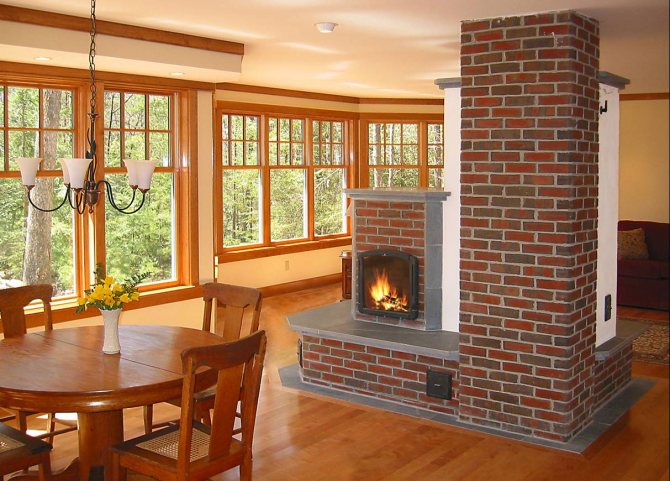

A brick oven can easily fit into the most modern interior design and even become its "highlight".
Today, among homeowners, interiors made in the style of chalet, country, and shabby chic are very popular. Their distinctive feature is the naturalization of various details and decorative elements. As well as possible, a brick Russian stove or fireplace will fit into such interiors, as a bright and stylish addition. These items can be a real highlight. To do this, they can simply be painted with transparent paint. However, before painting the surface, it must be properly prepared. If there are any visible defects on it, they must be eliminated by filling with putty. The latter is prepared by mixing latex paint and brick flour.
Choice of coverage
Standard paintwork cannot be used for fireplaces, because their surface, like that of a stove, heats up a lot. That is why in this situation paint with a heat-resistant effect is used, which includes elements that prevent loss of coating properties at the highest temperatures.
Refractory oven paint can withstand heat up to 650 degrees. Considering that the temperature emitted by the wood is 300 degrees, such a paint characteristic is acceptable.
Most often, a heat-resistant composition also performs a decorative function.
How to make DIY brick paint
You can achieve a beautiful shade of a brick oven yourself by making your own paint. First, red brick flour is rubbed. Whipped egg whites and milk are added to it until a thick consistency. The mixture is thoroughly mixed. You need to paint the stove with a new brush, applying paint to the surface of the stove preheated to a warm state. In this case, the brick surface acquires an even red color.This coating is heat-resistant and has increased abrasion resistance. At the end, the stove must be painted with linseed oil, which will make the dark red surface matte. If desired, you can get shine by applying a special synthetic varnish.
This type of painting a brick oven is approved by experts. After all, the resulting dense rough surface contributes to the greatest return of heat to the room and, having excellent elasticity, prevents the formation of cracks and various defects.
When faced with a choice of how to paint a brick oven, you can apply another method of preparing paint for a brick oven. All that is required for this is turpentine and PF-283 varnish. Both components are mixed in equal proportions. The result is a transparent, slightly matte blend. In order to give it the desired shade, you can proceed as follows: the gouache of a certain color is dried well and ground into a fine powder, which is added to the prepared mixture. The paint is ready to use.
Traditional folk recipes
Our grandmothers did not know what heat-resistant paints for brick stoves were, so they painted their stoves with chalk or lime, sometimes they painted them with national ornaments. But first things first.
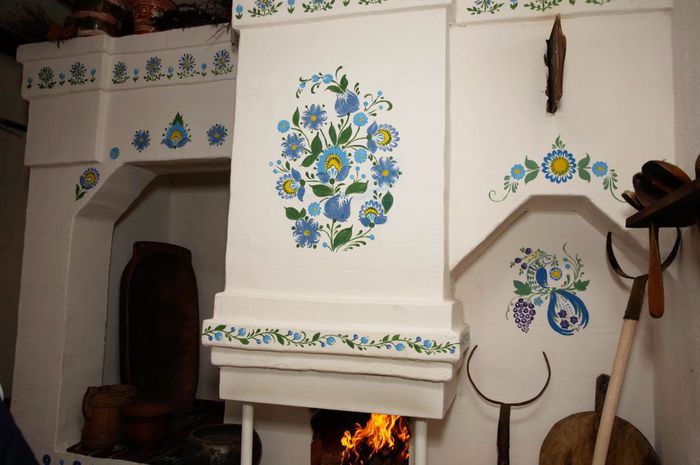

Rustic stove.
Cretaceous composition
- Traditionally, it is believed that the ratio of water to chalk should be 1.25 parts of water and 1 part of chalk. But in practice, chalk is usually poured into a container and poured with water until it is covered, after which it is left to decay for an hour. In parallel, natural glue is diluted with water to a liquid state. As a rule, carpentry or casein glue is used.
- Further, the chalk suspension is well mixed, until homogeneous, and an adhesive solution, 100 g of glue is added to a bucket of chalk suspension.
Tip: You can check the consistency by dropping it onto the glass and turning the glass vertically. If the drop slides no more than 3 cm, the solution is ready.
- You can tint such a paint with blue or potassium permanganate, but now it is problematic to find them in the retail network, so you can use factory heat-resistant dyes.
- It is difficult to work with the chalk composition, it can foam, it is difficult to achieve a uniform surface when painting, and the most unpleasant thing is that it does not hold firmly on the surface.
Whitewashed Russian stove.
Lime composition
- For preparation, quicklime is mixed with water in a proportion of 1 kg of lime to 1.5 liters of water and brought to a homogeneous state. After that, for plasticity, 1 teaspoon of linseed oil is added and in order for the lime to not smear after drying, 5 g of table salt is added.
- The lime composition is tinted in the same way as the chalky one. The only difference is that the 2nd coat must be applied to a damp surface and the chalk must dry. It is better to take fresh lime.
Important: it is strictly forbidden to put a lime composition on a chalk one or vice versa. If such a need arises, the bottom layer must be washed off.
The simplest homemade paint
- If grandmother's recipes are not suitable, and the price of heat-resistant compounds "bites", then paint for a brick oven can be prepared by hand. To do this, take PF-283 varnish and mix 1: 1 with turpentine or solvent.
- This mixture can be used immediately as a protective layer when the masonry itself looks good. The composition is transparent, with a light matte haze. You can add color using dried gouache powder.


Painted brick grill.
Restoration of appearance
- There are times when painting a brick oven, in the traditional sense, is not required, but the brick is covered with a mesh of small cracks that spoil the view. There is an old and very reliable recipe for resuscitation of such a surface.
- The same brick that was used in the masonry is taken and pushed into dust.After that, natural non-powdered milk and egg white from about 10 to 12 eggs are added. All this, everything is well mixed and brought to the desired consistency. The mixture is applied with an ordinary hard brush.
Tip: for artistic painting, you can take 1 liter of water, add 1 egg white and tint with gouache.
Advantages and disadvantages of heat-resistant paint
The heat-resistant paint used for painting a brick oven has a number of advantages. The surface treated with it acquires certain properties: wear resistance, heat resistance, electrical insulation. It protects the brickwork from oxidation, contributes to its strength and endurance. It is quite easy to paint the stove, and no pre-application of primer is required. The paint retains its performance for ten years.
The disadvantages of heat-resistant paints include an aggressive chemical composition and an unpleasant odor. They have a long drying time. When working with such paints, precautions should be taken due to the presence of toxic substances in their composition.
Heat-resistant paint for brick ovens
Speaker: Heat-resistant enamel CERTA up to 900 degrees. These paints are experts in heat resistant coatings. A good bucket will come in handy later when we use paint. You can pour a lot of useful things into such a bucket, useful for a garden. The service life of the coating in an industrial atmosphere of a temperate and cold climate is 15 years.
Painter: The paint is always matched to the surface to be painted. And when painting surfaces exposed to heat, such as radiators, or in our case this is an oven, use a special heat-resistant paint.
Recommendations for the stylish design of the stove
Any designer involved in drawing up architectural projects can help to make a stylish design of the stove and answer the question of how to paint a brick stove in a house. Also, a large number of creative ideas are on the Internet.
As for fashion trends, today all the designers of the world recommend decorating such heating units to a minimum, resorting to natural finishing materials and uniformity, deciding how to paint the stove. That is, some art objects and colored drawings are gradually going out of fashion. Stoves decorated with natural or artificial stone, as well as those complemented by ordinary ceramic tiles, look interesting.


Nowadays there is a clear tendency towards naturalization of interior elements and details. It is impossible to ignore such a bright and imaginative component of the design as an oven. It emphasizes the color, the Russian style, since it has long been considered an integral part of Russian life and culture. The growing enthusiasm for rustic styles (country, Provence, etc.)
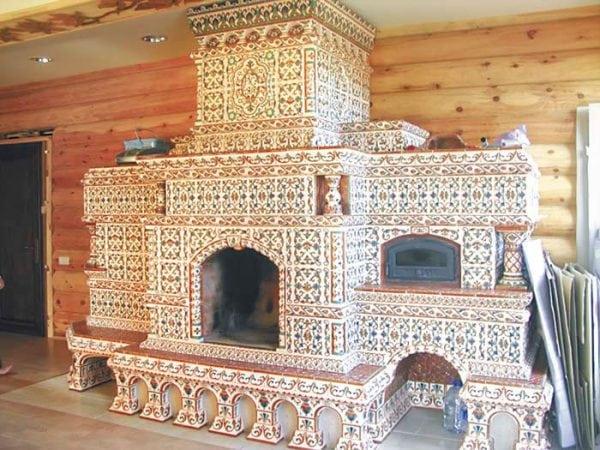

A beautifully designed stove will add its own zest to the interior design
Even covering the oven with transparent paint can make it a work of art. But, before you paint a brick oven, you need to give it an appropriate, natural look. Having cleaned it of dust and debris with a putty, they first eliminate all possible defects (cracks, damage, etc.). The putty can be made by hand by adding brick flour to the latex paint.

